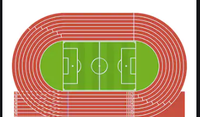pretzelboi
New member
- Joined
- Sep 15, 2019
- Messages
- 3
I'm super confused and have a mat test tomorrow please help! Thank you!!
Wake County Middle School needs to mow the grass in the middle of the track. The interior straight segments are approximately 84 meters and the curved semicircles are about 115 meters. How much area will need to be mowed? Round the solution to the nearest hundredths place.
Wake County Middle School needs to mow the grass in the middle of the track. The interior straight segments are approximately 84 meters and the curved semicircles are about 115 meters. How much area will need to be mowed? Round the solution to the nearest hundredths place.

